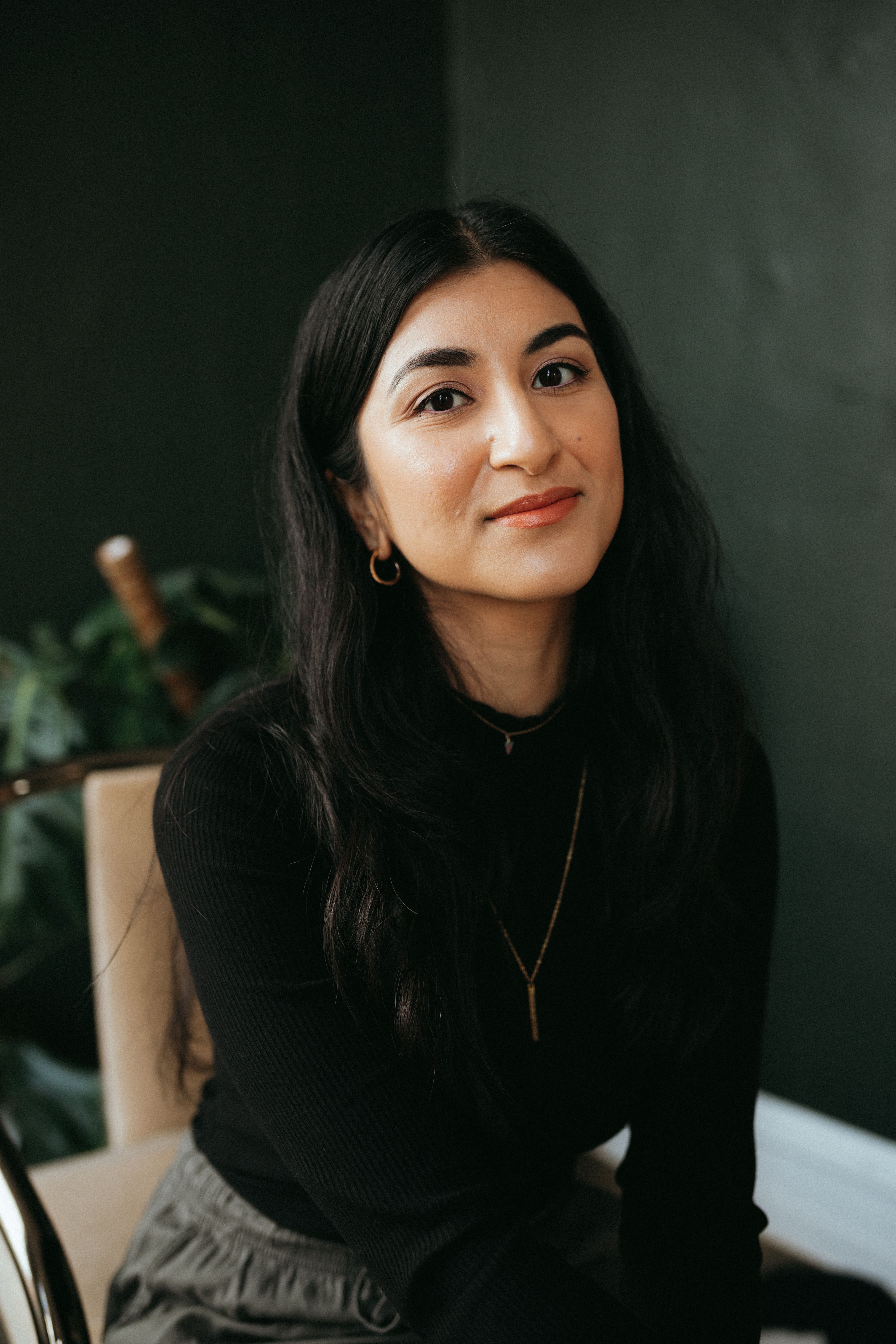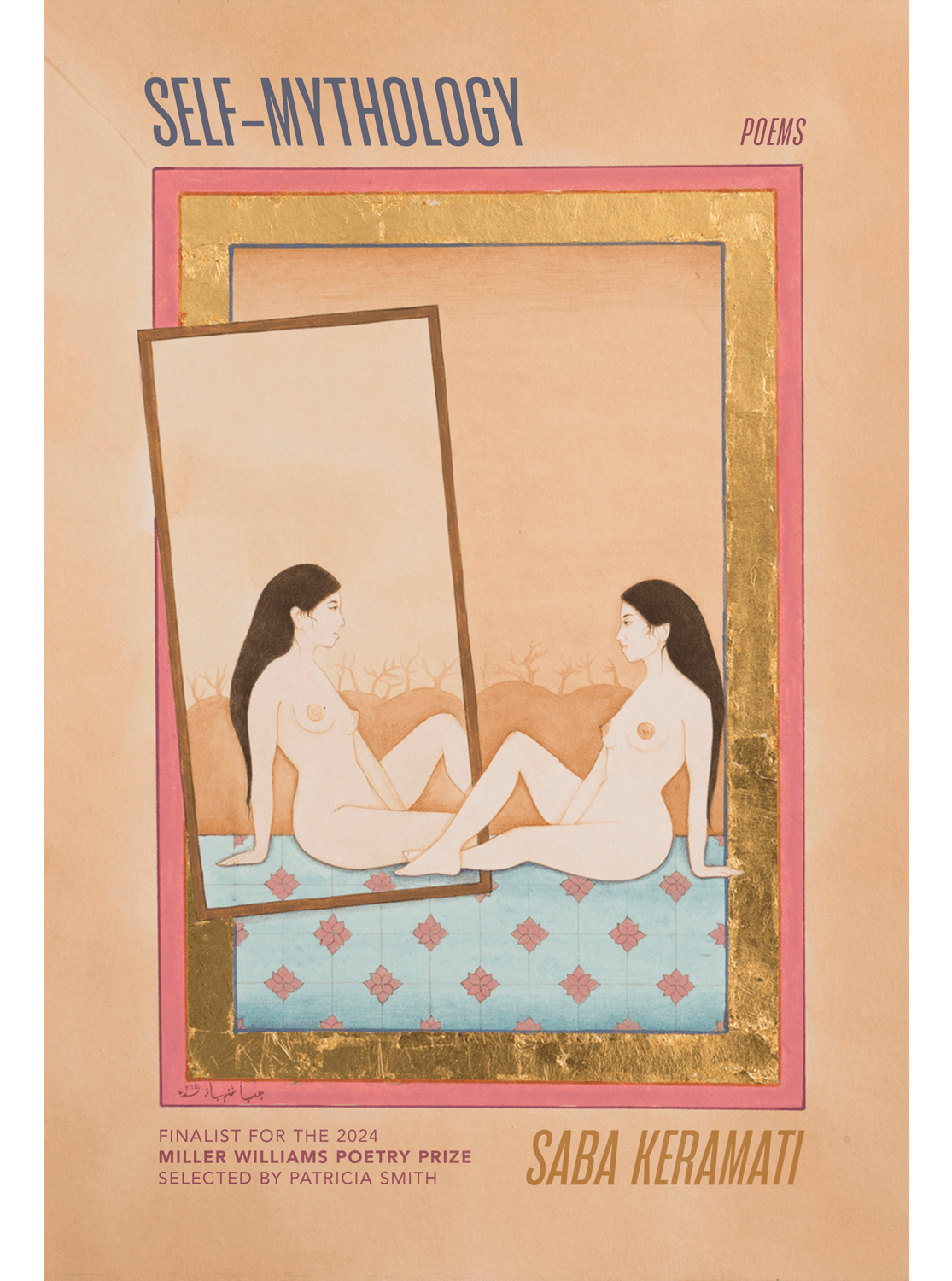Saba Keramati Publishes Debut Poetry Collection, "Self-Mythology"
Recent Alum Interview
Saba Keramati’s debut poetry collection, Self-Mythology, was selected by Patricia Smith for publication in the Miller Williams Poetry Series at University of Arkansas Press. A winner of the 2023 92NY Discovery Poetry Prize, Saba holds an MFA from UC Davis, where she was a Dean’s Graduate Fellow for Creative Arts. She is the Poetry Editor at SundogLit.
Saba will be returning to UC Davis for a reading on April 3.
The title is an incredible nod to how we may interpret ourselves but instead encounter a falseness. Can you talk about the concept of "self-mythology" and how it shaped the themes of your book?
I think much of the coming-of-age narrative is rooted in a balance of radical acceptance and righteous anger of what has been done to us to shape us into the people we are. (Some might say this is distinctly millennial-coded, but I think maybe millennials are just more accustomed to living in an unknown state.) The concept, the phrase of “self-mythology” speaks to several themes in the book. The arc of this collection follows that of a Kũnstlerroman, in that the speaker is working very clearly toward becoming an artist, and poetry becomes the vehicle through which she explores and understands her familial history and current self. “Self-mythology” also speaks to a certain air of solitude or loneliness. Often, when we think of myths, we think of them as cultural tales, so the idea that the speaker has to come to her own self’s understanding on her own is reflected in the phrasing of the title. And finally, we have the hyphenation of the phrase itself, at once “self,” at once “mythology” and at once something larger, much like the speaker herself as she navigates a mixed-race identity.
Patricia Smith described Self-Mythology as “the book we need right now, as so many of us explore our hyphenated selves, searching for meaning in being not all one and not all the
other, wondering if and where we are truly rooted. But even as we turn inward for clues, we’re a suspicious, judgmental lot.” Do you feel this was in response to your poems navigating what it means to be a daughter of political refugees from China and Iran?
I’m incredibly thankful to Patricia for reading this book so closely and for really seeing both the longing and the hypercritical eye that is present in so much of this book. When I was writing this book—and maybe even earlier, as I even thought of its possibility—I feared that no one would have any interest in it, that it was too specific to my own experiences, too niche in its categorization. Patricia’s introduction reminded me that these concepts of duality, of feeling split and looking for wholeness exist across empirical categories and borders.
There is the opening poem, “THERE IS NO OTHER WAY TO SAY THIS,” which I think encapsulates so much of what your collection is setting forth in its use of multiple languages, the incompatibility of a lineage’s past and present ideas of America, and the regretful acknowledgment of refugees fleeing violence for a life of continued violence. But then there are poems like “Hollowed” and “Self-Portrait with Crescent Moon and Plum Blossoms” where language takes shape as body. Teeth, bones, blood, skin – how do you see the body functioning as myth?
What I love about myths is that they are so often rooted in a desire to understand. Before science, myths explained landscape phenomena or human patterns of behavior. The speaker in Self-Mythology’s landscape is that of her own “self,” and the body/mind question expands the notion of what a “self” is. This comes at the speaker both internally, through her own examinations of hyperfocus, as well as externally, through the systemic violence enacted on a brown woman’s body in America. Unworthiness, like everything else heteropatriarchal white culture wants you to believe about yourself, is a myth. Scarcity is a myth. So the question becomes what does it mean to push back against the myths used to oppress, and what tools do you have with which to do it? Poetry, for one. The body, too. And so they connect.
Are there specific myths, cultural traditions, or literary influences that served as a foundation for this collection? Are there any specific works that felt like a touchstone during your writing process?
I love this question! There are a few moments of pointed intertextuality in the collection (namely, the short series of centos and a few poems that directly reference other, more famed works of poetry like Whitman’s “Song of Myself”). My hope was to somewhat elevate these referenced poems to mythic proportions for the speaker, to really hone in on the role poetry can serve in understanding oneself.
I am thinking now about the dichotomy between the fates of Narcissus and Echo—are we doomed to a life of only being able to repeat back what others have said, or are we so self-absorbed that our art dooms us to an eternity of being unable to look beyond ourselves? Maybe that’s just a question of what it means to publish poetry in this day and age.
What do you see as the role of mythology—personal or collective—in contemporary poetry? How does Self-Mythology contribute to this ongoing conversation?
I think contemporary myths allow us to redefine the self, in the new (and somewhat bizarre) contexts of contemporary American life. They recontextualize systems of power. I’d like to shoutout a few recent debut collections that I think operate in this way, if I may—
Theophanies by Sarah Ghazal Ali uses the language and stories of scripture to question cultural interpretations of faith-based texts. Black Pastoral by Ariana Benson gives new life and tenderness to historical atrocities. Cloud Missives by Kenzie Allen carefully examines Indigenous stereotypes through pop culture imagery. How to Kill a Goat & Other Monsters by Saúl Hernandez queers our understanding of desire through magical realism. The Lengest Neoi by Stephanie Choi uses Cantonese and English to rewrite a narrative of disability. The Girl Who Became a Rabbit by Emilie Menzel is a book-length lyric that mythologizes grief. And forthcoming this year is night myths • • before the body by Abi Pollokoff, which promises to mythically connect ecopoetics and feminist thought.
I hope that Self-Mythology contributes to the growing mythos of young, marginalized poets writing through this current moment. I hope all of that pushes back against widespread fascism and anti-intellectual discourse.
Workshops are such a valuable resource within the MFA program, so I wonder: how much of this collection did you work on during your time in the MFA program? Were there any classes or professors in particular that supported your work?
Self-Mythology would quite literally not be here without the help of Katie Peterson and Margaret Ronda. I’m so grateful to have had these two incredible women guide me through the UC Davis MFA. I wrote more than half of this collection while living in California, and two of those three years I was attending workshops in the Davis MFA. I also feel incredibly lucky that the friends I made in my MFA cohort were (and still are!) the most supportive group of people I could have ever hoped for them to be. I loved how the classes at Davis asked us how to live as writers, and not only how to write. Margaret had us at the university museum writing poems about artwork she specifically picked out for us. Katie had us read writers’ notebooks and keep one ourselves. Melinda Moustakis, a visiting professor, had us practice morning pages. All of this helped propel me on a journey toward Self-Mythology beyond the book, and toward the physical act of being a writer.
That’s really wonderful to hear that you found support in the MFA program! Can you speak a bit about your experience completing your thesis? Is this where Self-Mythology came into fruition?
I didn't know it then, but I wrote a poem that ended up appearing in my book during the very first quarter of workshops at UC Davis. It feels very sentimental to think that “the book” was coming to fruition before I even had a clear concept of it. I don't remember how many drafts of the thesis I put together. Probably between 10 and 20. The feedback from Margaret and Katie was absolutely invaluable. In the two years I worked on the thesis after graduating, I wrote new poems, revised poems from my thesis, and also threw out many poems that I felt no longer fit my needs as the focus of the book tightened. And although I technically added a prequel poem to the collection, the opening and closing pages of Self-Mythology remain the same as the (very different) thesis I turned in to graduate. Without that skeleton, I don't think I would have been able to find the heart of what I was really writing as quickly as I did. A two-year MFA is short! I'm so glad that I had the opportunity to both write poems that went into the book and to write poems that ended up living only in my Google Docs – it granted me the skills to really work through what makes a book a book.
I'd also like to shout out the Margrit Mondavi Fellowship at UC Davis for summer funding, which gave me the time and flexibility to be able to research and travel during my summer in the program. I also loved teaching at UC Davis. One, because it allowed my graduate studies to be funded and paid, and two, because the English and Creative Writing faculties at Davis are truly fantastic. I learned so much from both taking graduate-level literature classes and from TA'ing the undergraduate ones. In my second year, teaching three terms of creative writing helped me get my foot in the door for other freelance teaching jobs in my future, and I'm grateful to the opportunities and people at Davis for showing me what kind of teacher I want to become when I am in the classroom.
Now that Self-Mythology is out in the world, what’s next for you as a poet? Is there anything you’re excited to explore in future works?
“What’s next” is a question I love asking other poets and a question I hate answering myself. I am still writing! Some of the themes and images that have been cropping up in my poems are: the domestic, tarot, chronic pain, my father, and community care.


